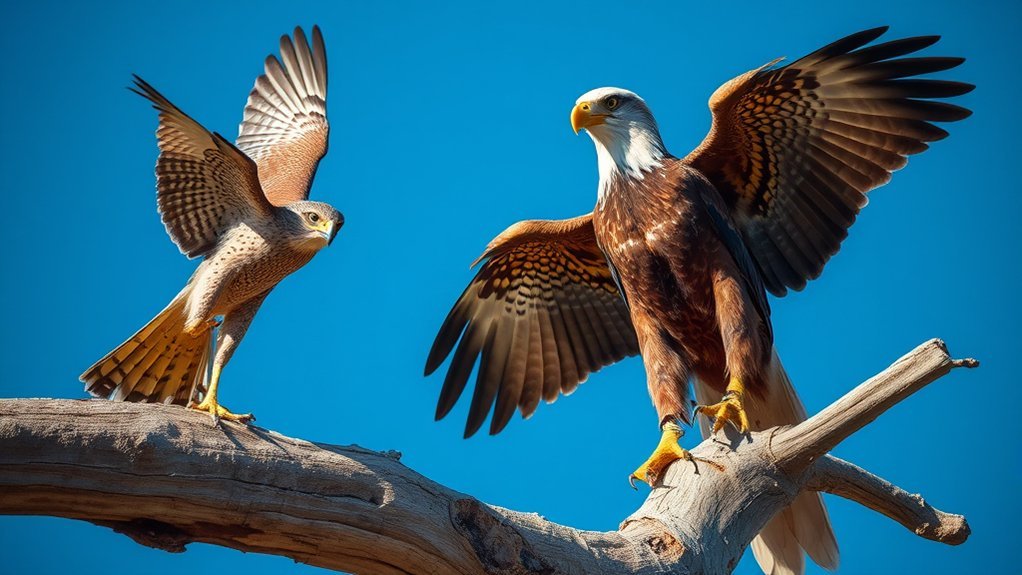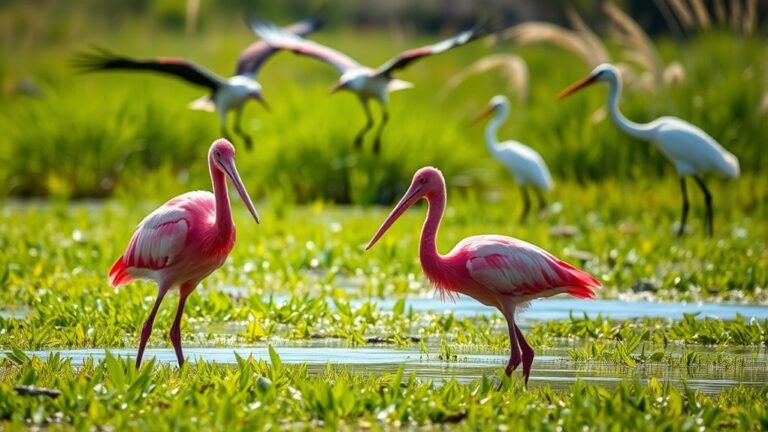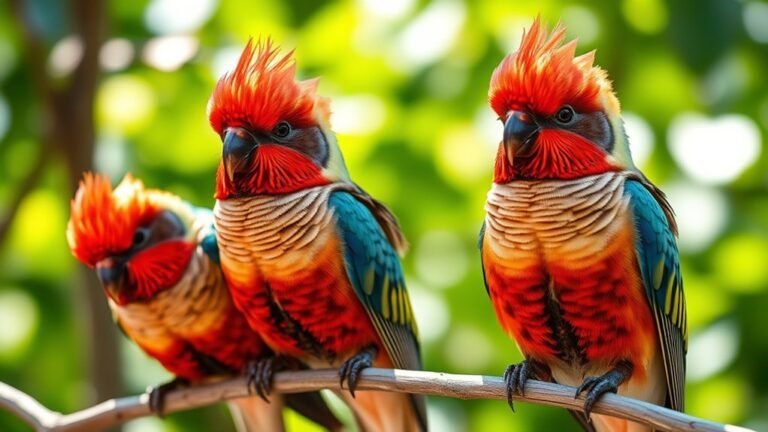Falcon Vs Eagle: Key Differences Explained
Falcons and eagles are both amazing birds, but they have some big differences. Falcons are built for speed. They have slender bodies and can fly really fast. Eagles, on the other hand, are strong. They can soar high and have powerful wings.
These birds live in different places and act in unique ways. Falcons often fly alone, while eagles can be more social and live in pairs or groups.
When it comes to having babies, they have different strategies too. Each bird finds its own ways to survive in the wild.
As you learn more about these birds, you'll find even more cool facts about how they live and hunt. What else are you curious about these fascinating raptors?
A Quick Overview
Falcons are smaller birds with pointy wings and slim bodies. Eagles are larger with wider wings and sturdy bodies.
Falcons are super fast! They can dive at speeds over 200 mph. Eagles, on the other hand, are great at soaring high in the sky.
When it comes to hunting, eagles chase bigger animals. They use their strength to catch them. Falcons hunt smaller animals. They are quick and precise.
Falcons can live in many places, including cities. Eagles like open areas and tall trees for nesting.
Their social habits are different too. Some types of falcons like to hang out in small groups. Eagles usually stay solo or pair up during nesting.
In short, while falcons and eagles are both amazing birds, they have their own special traits and habits!
Physical Characteristics of Falcons
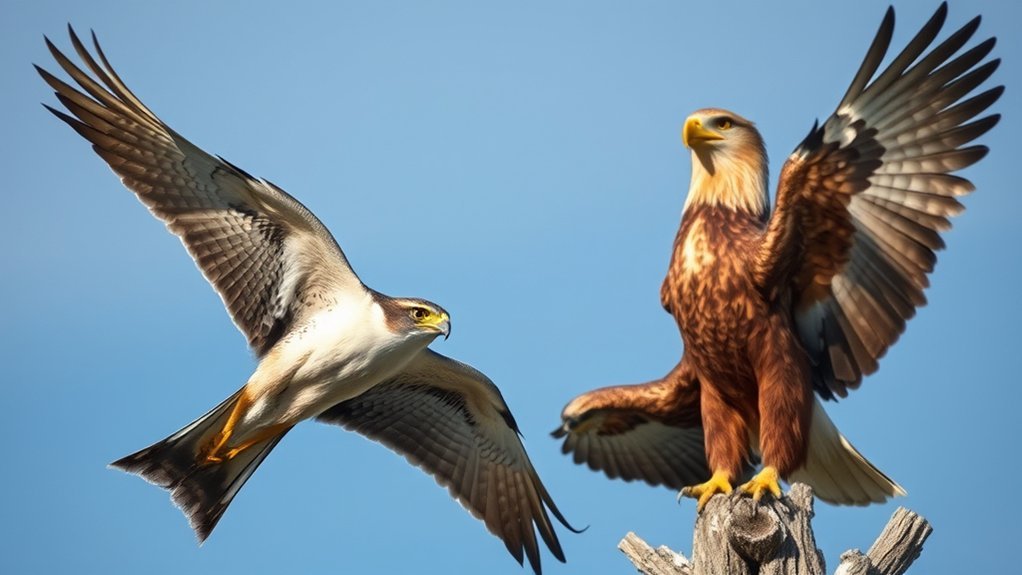
Falcons are amazing birds, and their looks make them easy to spot. They often have colors like soft browns, grays, and some bright blues. These colors help them blend in when they fly or sit still. Each kind of falcon has its own unique feathers, showing how they fit into different places.
Falcons come in many sizes. For example, the peregrine falcon can grow to be about 20 inches long. Some smaller falcons are only around 12 inches. They've long, pointy wings and slim bodies, which help them fly fast and move quickly when hunting for food.
Learning about these cool features helps you appreciate falcons even more. Plus, it connects you with other people who love birds too!
Physical Characteristics of Eagles

Eagles have some really cool features that make them stand out. One of the most impressive things about eagles is their huge wingspan. In some types, their wings can be as wide as seven feet! This helps them soar high in the sky, using warm air to stay up without flapping their wings too much.
Another amazing thing about eagles is their eyesight. They can see prey from more than two miles away! Their vision is four to eight times better than ours. This sharp sight is one reason why they're great hunters.
These physical traits show why eagles are top predators among birds. When you learn about their wings and eyes, it's easy to see why people admire them so much in nature.
Hunting Techniques of Falcons
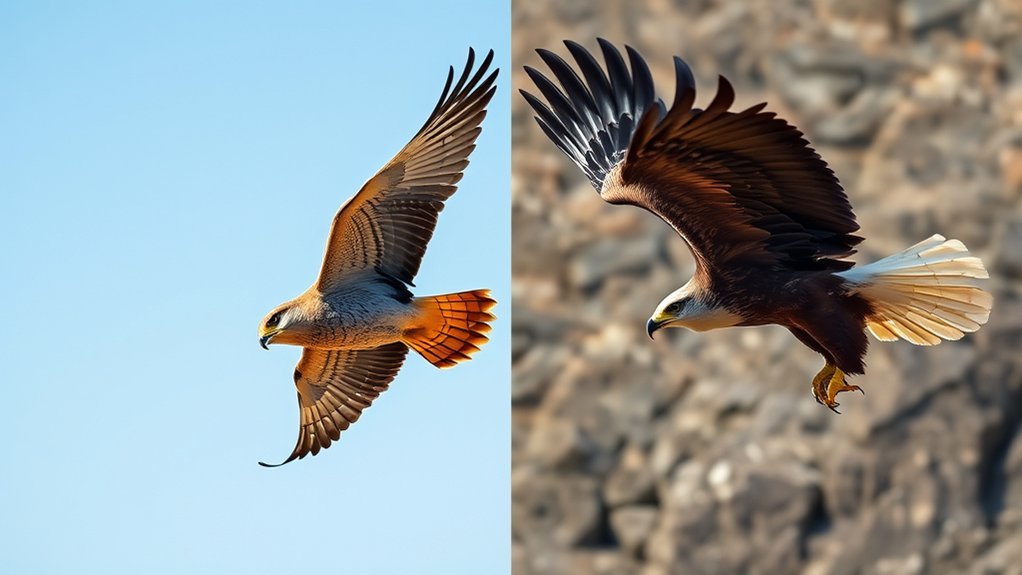
Falcons are amazing birds that hunt in a special way. They're super fast and can dive down to catch their food. Sometimes they go over 200 miles per hour when they dive! This speed helps them to swoop down and grab their target quickly.
When you watch a falcon, you'll see it looking around with its sharp eyes. They're good at spotting movement on the ground. Once they see something to catch, they dive down fast, showing off their flying skills. This exciting hunt is fun to watch and shows how clever they are.
Falcons make hunting look like a dance in the sky. If you ever get the chance to see one, it's a sight you won't forget!
Hunting Techniques of Eagles
Eagles hunt in a special way that takes advantage of their amazing eyesight and flying skills. They can see very far and spot their food from high above in the sky. While soaring, they carefully look around and can find fish or small animals with great precision.
Some eagles don't hunt alone. Many types of eagles work in pairs to catch their meals. You might see two eagles teaming up, which helps them catch prey more easily. This teamwork shows how smart they're and helps them connect with each other.
Habitat Preferences of Falcons
Falcons are unique birds with different home preferences compared to eagles. While eagles often hunt near water or in open fields, falcons can live in many places. They're good at finding the right spots based on how they like to hunt.
- Cities: Falcons can do well in urban areas. They use tall buildings as places to sit and nest, showing how well they adapt to city life.
- Open Areas: Falcons love wide spaces, like grasslands or deserts. In these places, they can see far and spot their meals from a distance.
- Mountains: Falcons also like rocky areas. These spots give them ledges to nest on and plenty of places to hunt.
These birds are truly flexible in where they live and hunt, making them strong predators in different environments.
Habitat Preferences of Eagles
Eagles like to live in places where they can easily find food and build nests. They often choose spots near large lakes or rivers because these areas have plenty of fish.
But eagles also enjoy wide-open fields and mountains. These places give them access to other food, like rabbits and small animals.
When it comes to making their homes, eagles pick tall trees or cliffs. They usually return to the same nesting spots year after year. This helps keep their babies safe and makes it easier for both parents to find food.
Eagles need the right habitats for their families to thrive. The right location helps them survive and raise their young.
Social Behavior in Falcons
Falcons are really interesting birds, and they show different ways of behaving around one another. Knowing how they act can help us appreciate them more. Here's a simple look at how they socialize:
- Territory fights: Falcons can be fierce when they protect their space. They use loud calls and fly high to show they're in charge.
- Group behavior: Some falcons like to be alone, but others, like the Prairie Falcon, enjoy hanging out in small groups when they travel or hunt together.
- Mating dances: When falcons want to find a mate, they often put on a show. They make impressive aerial moves and sometimes bring food as gifts to show their love.
These behaviors highlight how falcons mix their independence with social life.
Their way of living and interacting helps them survive and stay connected with each other. It's fun to learn about their social habits!
Social Behavior in Eagles
Eagles have interesting social behaviors that show how smart and adaptable they are. They're very territorial and form strong family bonds. Most eagle species mate for life, creating lasting partnerships that help their groups function well together.
When you watch eagles, you can see them sharing hunting areas and keeping an eye on their nests. They show dominance while still working within their social groups.
During colder months, eagles often roost together. This helps them stay warm and watch for danger in a group.
These social actions strengthen family connections and create a sense of belonging among eagles. By learning about these behaviors, we can appreciate how eagles live and succeed in different environments.
Reproductive Strategies of Falcons
Falcons are amazing birds with special ways of raising their young. They perform fun flying tricks to impress their mates. These tricks show off how fast and skillful they're in the sky. When it's time to have babies, falcons choose safe places to make their nests, like high ledges or even buildings made by humans.
- Falcons usually lay between 3 to 6 eggs. This helps make sure some will grow into baby birds.
- After the eggs are laid, they sit on them for about 30 days. Both mom and dad take turns keeping them warm.
- Once the baby chicks hatch, the parents feed them a lot and take good care of them. This shows how much they care about their little ones.
Learning about how falcons raise their chicks helps us appreciate their strength. They're clever and can live in many different places.
Reproductive Strategies of Eagles
Eagles have interesting ways of raising their young. When they choose a mate, they often perform cool aerial dances to show off their strength. This fun display helps them form a close bond.
After they become a pair, eagles pick a good spot for their nest. They often go back to the same place each year.
Eagles build strong nests using sticks and make them cozy with softer materials. They usually lay one to three eggs.
Both parents take turns sitting on the eggs to keep them warm. When the baby eagles, or eaglets, hatch, the parents are very caring. They feed their eaglets and protect them until they can take care of themselves.
This careful approach helps the eagles raise strong and healthy young.
Frequently Asked Questions
How Do Falcons and Eagles Differ in Vocalizations?
Falcons and eagles have different ways of talking. Falcons make sharp, quick sounds. These calls can be short and loud. Eagles, on the other hand, have deeper and more resonant sounds. Their calls are softer and more drawn out.
These sounds help each bird communicate in its own way. The sharp calls of falcons can be heard over long distances and are great for quick messages. Eagles use their deeper calls to communicate in more calming ways. Each type of call fits how they live and what they need to say to each other in their environments.
What Is the Lifespan of Falcons Compared to Eagles?
Falcons and eagles have different lifespans. Falcons usually live between 5 and 15 years. Eagles, on the other hand, can live much longer, from 20 to 30 years. Their lifespan can change based on where they live and what they eat.
In short, eagles generally outlive falcons by a significant amount. So, while falcons are fast and agile, eagles have the advantage of a longer life.
Are Falcons or Eagles More Endangered?
Both falcons and eagles face dangers in the wild, but eagles are typically more endangered. These beautiful birds need safe places to live and hunt. Conservation efforts aim to protect their homes and teach people about these amazing animals. This work is important to help ensure that eagles and falcons thrive for future generations.
Which Bird Is Faster in Flight, Falcons or Eagles?
When we look at how fast falcons and eagles fly, we see that falcons are the winners. They are built for speed and can dive really fast. Eagles, on the other hand, are good at soaring and gliding through the air. So, if we are talking about speed in the sky, falcons take the lead. It's pretty cool to think about how each bird has its own special way of flying!
Do Falcons and Eagles Have Similar Global Distributions?
Falcons and eagles live in many different places around the world, but they act quite differently when it comes to moving around. Eagles mostly stay in cooler places and often migrate to find food or better weather. On the other hand, falcons can live in a wide range of environments. They are very good at adjusting to different habitats, which helps them survive.

Luna is the passionate founder and author of Birds and You, a website dedicated to sharing her love for birds with fellow enthusiasts. Through her engaging articles and guides, she aims to educate and inspire others to explore the fascinating world of birds. When she’s not writing, you can find Luna observing birds in their natural habitats or sharing beautiful bird photography on Pinterest. Join her on this journey to celebrate and protect our feathered friends!

